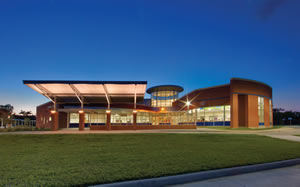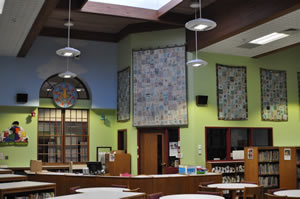Intelligent Buildings

PHOTO COURTESY OF LOUISIANA CONTROLS, A MEMBER OF THE INSIDEIQ BUILDING AUTOMATION ALLIANCE
Upgrading the energy performance of
school facilities offers many long-term benefits, including
improved facility efficiency, enhanced occupant comfort
and reduced operational costs, while having a positive environmental
impact, such as reducing carbon footprints. Applying the
capabilities of a building automation system (BAS) is an effective
way to gain energy efficiency and reduce utility charges. Sometimes
this requires the addition of direct digital controls (DDC)
to a school or a district may need to train staff to more effectively
apply an already existing BAS.
Before you can begin to use BAS technology to reduce energy
costs, it’s necessary to understand the facility’s actual energy use.
Benchmarking the energy consumption of your school buildings will
provide a baseline from which to begin mapping out a program to
lower energy use and reduce utility charges. The U.S. Environmental
Protection Agency’s ENERGY STAR program features an excellent,
easy to use benchmarking tool. After populating fields with data
such as utility costs and square footage, you will understand how
efficiently your facility is operating based on a comparison to similar
buildings. Achieving a score of 75 or higher on the 100-point scale,
an indication the building is performing better than 75 percent of
comparable buildings, qualifies the facility to be Energy Star certified.
With the benchmarking complete, the next step is to evaluate
the systems in the school that use the most energy. These include
lighting, mechanical systems — such as chillers, boilers and air
handlers — and office and kitchen equipment. Conduct an energy audit to identify which building systems are inefficient and determine
what steps are needed to bring them to peak performance.
In older schools that still rely on pneumatic controls upgrading
to a DDC BAS is recommended. Fortunately, the investment is
well worth it because payoffs typical range from only one to three
years, depending on the size of the school.
Applying the capabilities of a digital BAS will enable a school to
achieve real energy savings. For example, it can be used to improve
the efficiency of mechanical systems by optimizing start-up
times, power-down times, and equipment sequencing — such as
setting back the thermostat in evenings and other times when the
building isn’t occupied and to program thermostats for seasonal
changes. Schools can reduce lighting costs by installing occupancy
sensors to automatically turn off lights when no one is present and
back on when people return and use light meters to turn off lights
when natural daylight is sufficient.
The experience of the Claiborne Elementary School in Baton
Rouge, La., demonstrates how the BAS can be applied to save energy.
When it opened, the Claiborne School initially experienced higher
operating costs than the 60-year-old facility it replaced. For the facility
staff, meeting the modern standards for ventilation and lighting while
operating the school with integrated technologies was a challenge.
This is not uncommon in school districts where tight budgets require
maintaining aging equipment past its useful life and employees are
more used to dealing with pneumatic rather than digital controls.
With outside help from a controls contractor and professional
energy managers, the facility staff at the Claiborne School learned
how to effectively operate the mechanical systems based on the
original specifications. Then they used the BAS to develop specific
modifications and refinements to the facility control sequences
and energy management functions to further increase efficiency.
These included changing the ventilation control strategies to more
closely match delivered fresh air ventilation volumes to the actual
needs of occupied spaces; applying discharge air temperature
reset control during periods of normal humidity levels; and adding
demand-controlled ventilation. The staff also took advantage
of the integrated BAS’s capability to analyze, trend and quantify
control functions and system operations to better understand how
all building systems functioned.
As a result of these efforts, the school reduced energy use by
46 percent, lowering annual energy operating costs from $2.07 to
$1.32 per square foot, an improvement over the first year operations
and well below the per square foot cost of the old school
facility. Furthermore, the energy efficiency improvement enabled
the Claiborne School to win the national Energy Star competition
The Battle of the Buildings in 2014.
The facility team at Claiborne School learned that they had the
tools to operate an energy efficient facility; they just needed guidance
in the application of the technology and interpretation of the data. For
many school districts, additional training may be the key to achieving
energy savings using the technology that’s already available.
Achieving maximum operational efficiency is not a one-time
endeavor, but rather requires constant monitoring and proactive
effort by the facility team. Fortunately, the BAS makes this possible,
as has been the experience of the Fort LeBoeuf School District in
Erie County, Pa. As part of the recommissioning process at several
school facilities, the district’s facility staff learned how to keep
systems operating at peak efficiency. Overtime, in a typical facility,
setpoints are overridden, sensors fail and other components break.
Now that facility managers at Fort LeBoeuf are aware of scheduling
and setbacks, they make sure those are occurring as intended and
they monitor components such as dampers or fans to be sure they
are functioning properly — not stuck in “on”, for example. By being
aware of these potential problems, the facility staff takes proactive
action to monitor and correct as soon as the problem begins, which
keeps the schools operating as intended, reduces energy costs and
maintains — or enhances — Energy Star ratings.
The Fort LeBoeuf district saves more than $160,000 annually after
completing a multi-phase facility enhancement program that included
lighting upgrades, adding a new BAS, and optimizing boiler plant
operations, in addition to commissioning major HVAC equipment. Significantly, all the renovated schools experienced strong gains in their
Energy Star ratings, including achieving a perfect 100 at one facility.

PHOTO COURTESY OF SMARTEDGE, A MEMBER OF THE INSIDEIQ BUILDING AUTOMATION ALLIANCE.
Efficient yet comfortable. The Fort LeBoeuf School District maintains energy efficiency at the Robison Elementary School in Erie, Pa.,
by managing and controlling mechanical systems and lighting with an integrated BAS.
Advances in BAS technology provide other benefits that school
districts will want to explore. For example, commercial facility
operators are starting to rely on building analytics to maintain and
manage their facilities. In the future, school facility teams will want
to take advantage of the benefits of analytics as well. Building analytics
involves gathering data from systems throughout a building,
including the BAS, the HVAC equipment, various sensors, lighting
controls etc. The analytics takes all of this data and interprets it in
order to build charts and trend reports revealing facility operations
and efficiency in real-time. Using data from analytics shifts the
focus for a facility staff from a reactive service model to one that is
more preventative. For example, the analytics can alert operators to
changes that indicate a potential problem is coming before a system
failure occurs. This allows technicians to pro-actively make repairs
or adjustments in advance, rather than after occupants complain.
Analytics requires strong, secure networks and powerful computers,
often contained in the cloud. The relative expense of the
application and the level of knowledge required of the facility staff
in order to interpret it means analytics are not prevalent in schools
yet. As use of the technology becomes more widespread, however,
it is likely that many school districts will want to adopt it.
Modern integrated BAS technology allows greater, more precise
control of the energy using equipment in schools, enabling facility
staff to more carefully manage operations to save energy. By first
taking steps to ensure all the systems in a school are operating at
peak efficiency and then maintaining them at that level using the
BAS, schools can be confident they are managing energy resources
wisely. Money saved could even be used to fund major equipment
replacements to achieve even more energy savings in the future.
New analytic technology allows facility operators to be pro-active
in preventing system failures that could reduce efficiency and
eventually schools will want to use analytics too, in order to get the
maximum energy savings using the BAS.
This article originally appeared in the issue of .